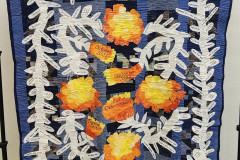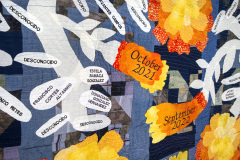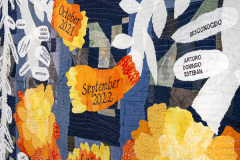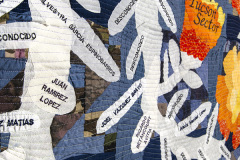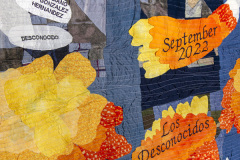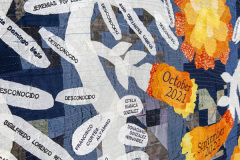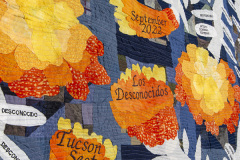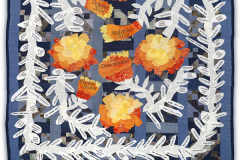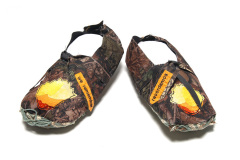Quiltmaker’s statement:
Cempasúchiles, 2023
by Melissa Bauer
clothing, cotton fabric, and dye
My artwork is a reflection of my interest in historical research and the American landscape. The
landscape addressed by this quilt is the Tucson Border Patrol sector, which covers 262 border miles in southern Arizona. It honors the lives of the people who died crossing the border between Mexico into the United States in the 2022 fiscal year. We lost them to hyperthermia, blunt force trauma, sharp force injuries, heat exposure, traumatic asphyxia, and multiple gunshot wounds. Their violent and unnecessary deaths do not define their lives, however. Each name on this quilt represents a beloved family member who will be deeply missed by their communities. Together, we mourn this huge loss.
Cempasúchiles is composed of three layers, which represent the three deaths of Mexican custom. The first layer of the quilt is the dark blue traditional quilt constructed from a historic quilt block pattern called “The Road to California” which was first published around 1890. Sewn with clothing left by migrants as they crossed the Tucson sector, it depicts the first death: when the body ceases to function. Representing the second death, when the body is buried, the second layer of this quilt references a popular applique pattern of flowers and leaves from the 1850s. The cempasúchil flowers in this layer are traditionally used to celebrate life and lead souls from their burial places to their family homes. The third layer of this quilt is the embroidered names of people who lost their lives crossing the border between October 2021 and September 2022, with “Desconocido” standing in for the 106 people who remain unidentified. This third and final layer prevents the third death: the moment when a person is remembered for the last time. Each leaf ensures they will not be forgotten.
The shoe covers displayed with this quilt were also found in the Tucson Sector. Their ingenuity
speaks to how loved the wearer was. A soft sole dampens footprints and the sound of footsteps. The velcro fasteners on the back allowed the wearer to slip them over their own shoes. The tie on the top ensures they stay on, aiding the wearer in their mission to start a new life. Displaying the shoe covers next to the quilt is meant to evoke the familiar, homey scene of slippers next to a bed. Something that you might put on every day without thought but convey warmth and comfort. They, too, have the cempasúchil flowers imagery to help bring the wearer’s soul back to their loved ones.
